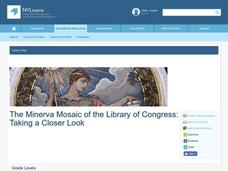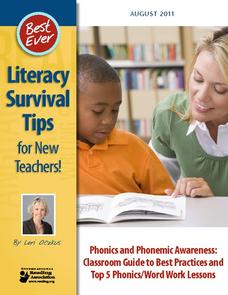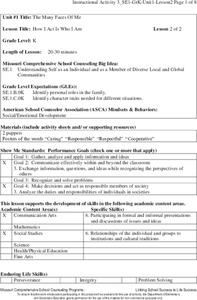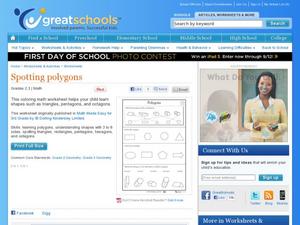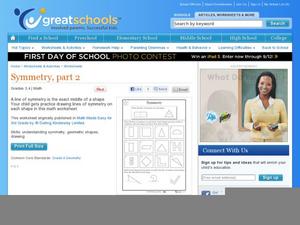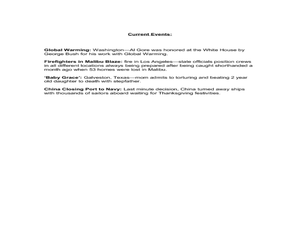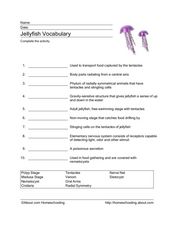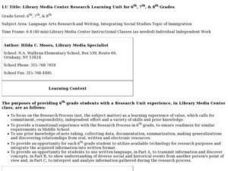Roseburg Public Schools
Library Skills and Literature
The library is such a valuable resource for kids of all ages. Help elementary readers learn all about parts of the library, text features for both fiction and nonfiction text, and different ways to find books that they want to read.
Curated OER
Starting an Elementary Book Club
Discover the benefits of starting a book club in this two-part article.
National First Ladies' Library
Why Do We Have Libraries?
Students investigate the reason and origins of libraries and conduct an information search using a variety of resources. They are divided into groups that have a specific set of questions they are to answer. Each group will then complete...
Curated OER
The Minerva Mosaic of the Library of Congress: Taking a Closer Look
Students take a closer look at the Minerva Mosaic. In this primary source analysis lesson, students use the provided analysis worksheets to study the Minerva image in the Library of Congress and all that it symbolizes.
Curated OER
Flying High in Arkansas: A Study of the State Flag
An outstanding activity on the Arkansas State Flag is here for you. In it, elementary schoolers learn about the symbolism of the flag, and create a replica of the flag as a final activity. They also memorize the Arkansas State Pledge,...
International Reading Association
Literacy Survival Tips for New Teachers!
Whether new to teaching or a seasoned pro, this 12-page phonics and phonemic awareness guide is a must for your curriculum library. Everything from a summary of research on the topic to exercises and activities is included.
Curated OER
Definitions by Context
Use this two-page resource either with your English language learners or your upper elementary native speakers. There are eight questions that test your learners' ability to use the context of a sentence to define an unknown word....
Curated OER
Four Storybook Apps to Add to Your Class Library
Young readers will love the colorful illustrations, whimsical narration, and interactive extras included in these digital tales.
Curated OER
Map Coordinates: Monkey Map
Here's an engaging, meaningful, and clever lesson on map skills for elementary schoolers. Pupils combine story writing with mapping skills to create an original piece of work. They utilize a worksheet embedded in the plan to guide them...
John F. Kennedy Presidential Library & Museum
Ask Not What Your Country Can Do for You
Ask not what the lesson here can do for you, but what you can do with the lesson. The answer is quite a lot! Young scholars revisit JFK's famous inaugural address with a focus on his plea for civic engagement. There's a letter to JFK...
Missouri Department of Elementary
How I Act Is Who I Am
A lesson centers itself around the topic of family roles. A whole-class discussion uses puppets and posters to go in-depth into the following character traits; caring, responsibility, respect, and cooperation. The discussion closes with...
American Institute of Architects
Architecture: It's Elementary!—First Grade
Build an interest and appreciation for architecture in your young learners with this fun 10-lesson art unit. Engaging children in using their five senses, the class first observes the environment around them, paying special attention to...
Cornell Lab of Ornithology
Amazing Birds
What's so amazing about birds? Find out just how amazing birds are with a physics of animal behavior unit created by Cornell Lab of Ornithology. Have learners explore and tap into their observational skills and notice how birds fly, what...
Curated OER
Same Shape and Size
Can your kindergartners recognize shapes? What about when they are in different orientations? Youngsters study groups of shapes to determine which have the same shape and size. Two of the groups have triangles and ovals, and the other...
Curated OER
Spotting Polygons
See all sides of the story with a worksheet on geometric shapes! After studying the example at the top, which matches polygons with solid figures, second graders circle shapes that are named in the directions. Next, they match polygons...
Curated OER
Symmetry, Part 2
How can you tell if shapes are symmetrical? Fourth graders study 12 shapes, and draw lines down the middle of shapes that have symmetry. Once they are finished, they complete shapes that are missing their symmetrical sides. Some shapes...
Curated OER
How Current Events Affect Us
Elementary and middle schoolers research a current event using various resources. They participate in a class discussion to evaluate the information they gathered on a particular event. Additionally, they discuss the concepts of common...
Curated OER
Jellyfish Vocabulary
In this jellyfish vocabulary skills worksheet, learners match the 10 listed jellyfish-related words to the appropriate sentences that describe each of them.
Curated OER
The Great Depression and New Deal
Elementary pupils are introduced to the Great Depression as a critical period of hardship in United States history. They engage in collaborative assignments researching the Dust Bowl, the New Deal, US presidents, and presidential libraries.
Curated OER
Burr Airlines Flight to Asia: Building Inquiry Skills
What a wonderful way to explore this topic! Learners take an imaginary trip to Asia, take a visual tour, and formulate questions for a research project. As a final project, they create a travel brochure.
DK Publishing
Using a Protractor
Learn how to measure acute, right, and obtuse angles with a protractor. After reviewing the way the protractor works, fourth graders measure nine angles on their own. For extra practice, have them measure different angles in their...
Curated OER
Library Media Center Research Learning Unit for 6th, 7th, & 8th Grades
Students focus on the process of and skills necessary for researching a topic. They study the topic of immigration while practicing note taking skills, organizing information and writing conventions.
Library of Congress
Investigating the Building Blocks of Our Community’s Past, Present, and Future
As Ken Jennings said, "There's just something hypnotic about maps." Certainly, the longer you look at them the more you can learn. In this project-based learning lesson plan, individuals study both historic and present-day maps of their...
Curated OER
Folktales of Zora Neale Hurston
Do you know why woodpeckers have red heads? Why the possum has no hair on its tail? Why a cat has nine lives? Find out by downloading this resource that uses Zora Neale Hurston's collection Mules and Men as the basis of a study of...





